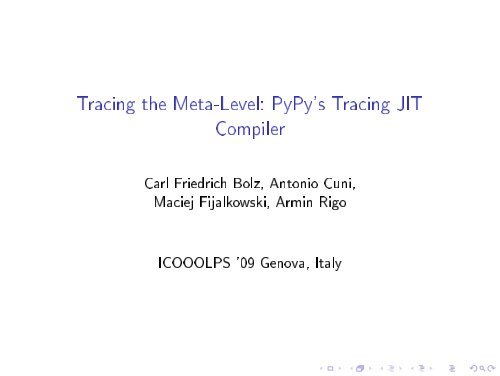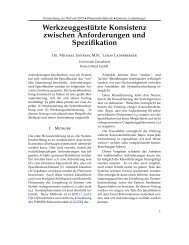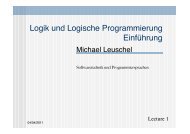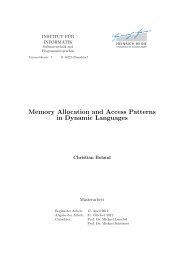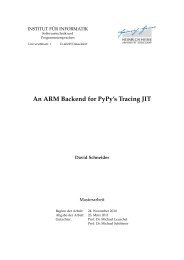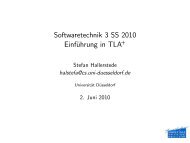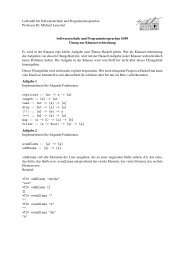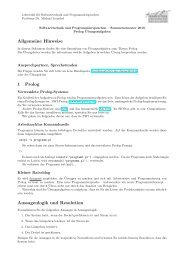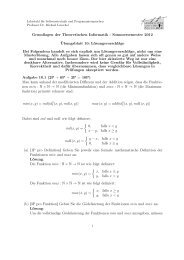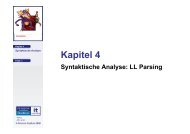Tracing the Meta-Level: PyPy's Tracing JIT Compiler
Tracing the Meta-Level: PyPy's Tracing JIT Compiler
Tracing the Meta-Level: PyPy's Tracing JIT Compiler
You also want an ePaper? Increase the reach of your titles
YUMPU automatically turns print PDFs into web optimized ePapers that Google loves.
<strong>Tracing</strong> <strong>the</strong> <strong>Meta</strong>-<strong>Level</strong>: <strong>PyPy's</strong> <strong>Tracing</strong> <strong>JIT</strong><br />
<strong>Compiler</strong><br />
Carl Friedrich Bolz, Antonio Cuni,<br />
Maciej Fijalkowski, Armin Rigo<br />
ICOOOLPS '09 Genova, Italy
Introduction<br />
◮ increasing popularity for Dynamic Languages<br />
◮ major drawback: slower than statically types languages<br />
◮ most implementations without advanced techniques like <strong>JIT</strong>s<br />
◮ interpreters are easy, just-in-time compilation is hard
Introduction<br />
What We want to do<br />
◮ improve performance of interpreters written with <strong>the</strong> PyPy<br />
toolchain<br />
◮ by using a tracing <strong>JIT</strong> compiler<br />
◮ but trace <strong>the</strong> interpreter execution instead of <strong>the</strong> user program
The PyPy Project<br />
What is PyPy?<br />
◮ environment for writing exible implementations of dynamic<br />
languages<br />
◮ implementations are written in RPython<br />
◮<br />
subset of Python that allows type inference<br />
◮ language interpreter can be translated to various target<br />
environments
The PyPy project<br />
Advantages for writing VMs in High-<strong>Level</strong> Languages<br />
◮ free of low-level details<br />
◮<br />
◮<br />
◮<br />
memory management<br />
threading model<br />
object layout<br />
◮ features are added automatically during translation process
The PyPy project<br />
The Translation Process<br />
1. control ow graph construction and type inference<br />
2. several steps to transform <strong>the</strong> intermediate representation into<br />
nal executable:<br />
◮<br />
◮<br />
rst: make details of python object model explicit in<br />
intermediate representation<br />
later: introduce garbage collection and o<strong>the</strong>r low-level details
<strong>Tracing</strong> <strong>JIT</strong> compilers<br />
◮ initially explored by <strong>the</strong> Dynamo Project<br />
◮ same techniques were used to implement <strong>JIT</strong> compiler for JVM<br />
◮ turn out to be a relatively easy way to implement <strong>JIT</strong><br />
compilers for dynamic languages<br />
◮ used for Mozilla's TraceMonkey JavaScript VM and Adobe's<br />
Tamarin ActionScript VM
<strong>Tracing</strong> <strong>JIT</strong> compilers<br />
Assumptions for building <strong>Tracing</strong> <strong>JIT</strong>s<br />
◮ programs spend most of <strong>the</strong>ir time in loops<br />
◮ several iterations (of one loop) take similar code paths
<strong>Tracing</strong> <strong>JIT</strong> compilers<br />
What should be traced?<br />
◮ only generate machine code for hot code paths of commonly<br />
executed loops<br />
◮ interpret <strong>the</strong> rest
<strong>Tracing</strong> <strong>JIT</strong> compilers<br />
<strong>Tracing</strong> <strong>JIT</strong> Phases I<br />
◮ interpretation/proling<br />
◮<br />
◮ tracing<br />
◮<br />
establish frequently run loops by counting backward jump<br />
instructions<br />
record history of all operations executed during one iteration of<br />
a hot loop<br />
◮ code generation<br />
◮<br />
use trace to generate ecient machine code<br />
◮ code execution<br />
◮<br />
use generated code in <strong>the</strong> next iteration
<strong>Tracing</strong> <strong>JIT</strong> compilers<br />
<strong>Tracing</strong> <strong>JIT</strong> Phases II<br />
◮ guards<br />
◮<br />
◮<br />
◮<br />
ensure correctness<br />
place guards at every point where <strong>the</strong> code could take ano<strong>the</strong>r<br />
direction<br />
failing a guard will return to interpretation<br />
◮ position key<br />
◮<br />
◮<br />
◮<br />
◮<br />
used to recognize <strong>the</strong> corresponding loop for a trace<br />
describes position of <strong>the</strong> executed programm<br />
contains currently executed function and programm counter of<br />
tracing interpreter<br />
check position key at backward branch instruction (or o<strong>the</strong>r<br />
position changing instructions)
<strong>Tracing</strong> <strong>JIT</strong> compilers<br />
Example for a Trace<br />
def f(a , b ):<br />
if b % 46 == 41:<br />
return a - b<br />
else :<br />
return a + b<br />
def strange_sum (n ):<br />
result = 0<br />
while n >= 0:<br />
# corresponding trace :<br />
loop_header ( result0 , n0 )<br />
i0 = int_mod (n0 , Const (46))<br />
i1 = int_eq (i0 , Const (41))<br />
guard_false ( i1 )<br />
result1 = int_add ( result0 , n0 )<br />
n1 = int_sub (n0 , Const (1))<br />
i2 = int_ge (n1 , Const (0))<br />
result = f( result , n)<br />
guard_true ( i2 )<br />
n -= 1<br />
jump ( result1 , n1 )<br />
return result
Applying a <strong>Tracing</strong> <strong>JIT</strong> to an Interpreter<br />
Terminology<br />
◮ tracing interpreter: interpreter <strong>the</strong> <strong>JIT</strong> uses to perform tracing<br />
◮ language interpreter: runs <strong>the</strong> user program<br />
◮ user program: program that <strong>the</strong> language interpreter executes<br />
(program that is being executed using <strong>the</strong> VM)<br />
◮ interpreter loops: loops inside <strong>the</strong> language interpreter<br />
◮ user loops: loops inside <strong>the</strong> user program
Applying a <strong>Tracing</strong> <strong>JIT</strong> to an Interpreter<br />
<strong>Tracing</strong> <strong>the</strong> Language Interpreter Loop<br />
◮ tracing jit is not applied to <strong>the</strong> user program but to <strong>the</strong><br />
interpreter running that program<br />
◮ problem:<br />
◮<br />
◮<br />
◮<br />
only hot loop: bytecode dispatching<br />
each iteration usually interprets dierent bytecodes<br />
in contrast to <strong>the</strong> assumption that a hot loop take similar code<br />
paths
Applying a <strong>Tracing</strong> <strong>JIT</strong> to an Interpreter<br />
<strong>Tracing</strong> <strong>the</strong> Language Interpreter Loop Exmaple<br />
def interpret ( bytecode , a ):<br />
regs = [0] * 256<br />
pc = 0<br />
while True :<br />
opcode = ord ( bytecode [ pc ])<br />
pc += 1<br />
if opcode == JUMP_IF_A :<br />
target = ord ( bytecode [ pc ])<br />
pc += 1<br />
if a:<br />
pc = target<br />
elif opcode == MOV_A_R :<br />
n = ord ( bytecode [ pc ])<br />
pc += 1<br />
regs [n] = a<br />
[...]<br />
elif opcode == DECR_A :<br />
a -= 1<br />
elif opcode == RETURN_A :<br />
return a<br />
loop_start (a0 , regs0 , bytecode0 ,<br />
opcode0 = strgetitem ( bytecode0 ,<br />
pc1 = int_add (pc0 , Const (1))<br />
guard_value ( opcode0 , Const (7))<br />
a1 = int_sub (a0 , Const (1))<br />
jump (a1 , regs0 , bytecode0 , pc1 )
Applying a <strong>Tracing</strong> <strong>JIT</strong> to an Interpreter<br />
How to Trace <strong>the</strong> User Program<br />
◮ do not trace a single opcode, but a series of several opcodes<br />
by unrolling <strong>the</strong> bytecode dispatch loop<br />
◮ unroll in such a way that <strong>the</strong> trace corresponds to a user loop
Applying a <strong>Tracing</strong> <strong>JIT</strong> to an Interpreter<br />
Detecting a User Loop<br />
◮ user loops occur when <strong>the</strong> program counter of <strong>the</strong> language<br />
interpreter has <strong>the</strong> same value several times<br />
◮ in this case <strong>the</strong> program counter is represented by <strong>the</strong> variables<br />
pc and bytecode<br />
◮ for <strong>the</strong> jit to know which variables are <strong>the</strong> program counter <strong>the</strong><br />
author needs to place hints<br />
◮ <strong>the</strong> jit will add <strong>the</strong>se variables to <strong>the</strong> position key<br />
◮ this way <strong>the</strong> jit will consider <strong>the</strong> loop to be closed if <strong>the</strong>se<br />
variables are <strong>the</strong> same a second time (-> user loop)
Applying a <strong>Tracing</strong> <strong>JIT</strong> to an Interpreter<br />
When to check for a Closing Loop<br />
◮ program counter of language interpreter can only be <strong>the</strong> same<br />
a second time if it is set to an earlier version by an instruction<br />
◮ this only happens at a backward jump in <strong>the</strong> language<br />
interpreter<br />
◮ jit needs ano<strong>the</strong>r hint to recognize a backward jump
Applying a <strong>Tracing</strong> <strong>JIT</strong> to an Interpreter<br />
When to use Generated Code<br />
◮ problem: all pieces of assembler code correspond to <strong>the</strong> same<br />
hot loop, <strong>the</strong> bytecode dispatch loop<br />
◮ however: <strong>the</strong>y correspond to dierent paths through that loop<br />
◮ need to check <strong>the</strong> program counter to pick <strong>the</strong> correct<br />
machine code<br />
◮ if program counter corresponds to <strong>the</strong> position key of one of<br />
<strong>the</strong> machine codes, this code can be executed<br />
◮ this only needs to be checked at a backward branch
Applying a <strong>Tracing</strong> <strong>JIT</strong> to an Interpreter<br />
Applying Hints<br />
◮ green variables: should be considered as part of <strong>the</strong> program<br />
counter by <strong>the</strong> jit<br />
◮ red variables: not important for <strong>the</strong> program counter<br />
◮ jit_merge_point: put at <strong>the</strong> beginning of <strong>the</strong> bytecode<br />
dispatch loop<br />
◮ can_enter_jit: marks <strong>the</strong> backward jump
Applying a <strong>Tracing</strong> <strong>JIT</strong> to an Interpreter<br />
Applying Hints Example<br />
def interpret ( bytecode , a ):<br />
regs = [0] * 256<br />
pc = 0<br />
while True :<br />
tlrjitdriver . jit_merge_point ()<br />
opcode = ord ( bytecode [ pc ])<br />
pc += 1<br />
if opcode == JUMP_IF_A :<br />
target = ord ( bytecode [ pc ])<br />
pc += 1<br />
if a:<br />
if target < pc :<br />
tlrjitdriver . can_enter_jit ()<br />
pc = target<br />
elif opcode == MOV_A_R :<br />
... # rest unmodified
Improving <strong>the</strong> Result I<br />
◮ result of <strong>the</strong> trace is not optimized enough<br />
◮ most operations are not part of <strong>the</strong> user program<br />
◮ a lot of operations needed to manipulate <strong>the</strong> interpreter<br />
◮<br />
◮<br />
read bytecodestring<br />
manipulate program counter
Improving <strong>the</strong> Result II<br />
◮ if operations are side eect free <strong>the</strong>se computations can be<br />
folded away<br />
◮ which is <strong>the</strong> case as <strong>the</strong> bytecode string is immutable<br />
◮ see paper page 22
Implementation Issues I<br />
◮ <strong>JIT</strong> should not be integrated, but added during C translation<br />
◮ interpretation of language interpreter is bad →<br />
double-interpretation overhead<br />
◮ instead run language interpreter as a C program<br />
◮ on nding a hot loop in user program start tracing<br />
◮ use current state to trace bytecode representation<br />
◮<br />
needs machine- and bytecode version in executable of VM
Implementation issues II<br />
◮ on failing a guard, fall back to normale interpretation<br />
◮ problem: hard to rebuild state in <strong>the</strong> middle of execution<br />
◮<br />
fallback deep in <strong>the</strong> code needs a deep C stack<br />
◮ solution: use fallback interpreter<br />
◮<br />
◮<br />
◮<br />
variant of langugage interpreter without tracing<br />
run until a safe point is reached where it is easy to resume<br />
operation in C version<br />
happens after at most one bytecode operation
Evaluation<br />
Small Interpreter<br />
◮ 2: slower than normaler interpretation due to overhead<br />
◮ 3: better than Benchmark2, but still slower than normal<br />
interpretation<br />
◮ 4: almost <strong>the</strong>e times faster<br />
◮ 5: proling overhead almost 20% of speed
Evaluation<br />
PyPy<br />
◮ PyPy with <strong>JIT</strong> is faster than CPython, but slower than<br />
CPython with Psyco
Related Work<br />
DynamoRio<br />
◮ applying a trace-based optimizer to an interpreter<br />
◮ adding hints helping <strong>the</strong> tracer produce better results<br />
◮ same unrolling as in this paper<br />
◮ however: tracing on machine code level<br />
◮<br />
◮<br />
◮<br />
no high-level information<br />
need much more hints<br />
advanced optimization techniques not possible
Related Work<br />
Piumarta and Riccardi<br />
◮ copy fragments of commonly occuring bytecode sequences<br />
toge<strong>the</strong>r<br />
◮ reduces dispatch overhead<br />
◮ problem: dispatching still needed to jump between those<br />
fragments and for non-copyable bytecodes
Related Work<br />
Ertl and Gregg<br />
◮ get rid of all dispatch overhead<br />
◮ stich toge<strong>the</strong>r concatenated sequences by patching copied<br />
machine code<br />
◮ won't help if bytecode itself does a lot of work and dispatch<br />
overhead is low
Related Work<br />
Partial Evaluation<br />
◮ some arguments are known (static)<br />
◮ some unknown (dynamic)<br />
◮ constant-fold all static arguments
Related Work<br />
Partial Evaluation at Runtime<br />
◮ Tempo for C<br />
◮<br />
◮<br />
◮ DyC<br />
normal partial evaluator "packaged as library"<br />
specializations are pre-determined<br />
◮ Problem: targeting <strong>the</strong> C language makes higher-level<br />
specialization dicult
Related Work<br />
Dynamic Partial Evaluation<br />
◮ There have been some attempts to do dynamic partial<br />
evaluation, which is partial evaluation that defers partial<br />
evaluation completely to runtime to make partial evaluation<br />
more useful for dynamic languages.<br />
◮ WTF!?
Conclusion and Next Steps<br />
◮ Allocation Removal<br />
◮<br />
objects allocated inside <strong>the</strong> loop and do not escape <strong>the</strong> loop<br />
don't need to be allocated on <strong>the</strong> heap<br />
◮ Optimizing Frame Objects<br />
◮<br />
◮<br />
◮<br />
reection of dynamic languages allow introspection of <strong>the</strong><br />
frame object<br />
thus storing intermediate result into <strong>the</strong> frame object rendering<br />
allocation removal ineective<br />
solution: update frame object lazily


